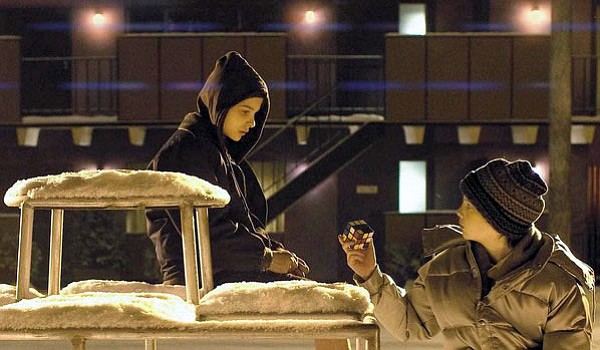Let Me In
2010

Rating: R
Genre: Horror
Country: U.S.
Run-Time: 1h 56 min
Director: Matt Reeve
Cast
Kodi Smit-McPhee……….Owen
Chloe Grace Moretz……..Abby
Richard Jenkins……………..Thomas
Hollywood has a bad reputation when remaking successful foreign horror films. Often the foreign counterparts are gritty, atmospheric affairs oozing in creativity and nihilism. But Hollywood has a history of taking these productions, giving them a glossy CGI shine, adding a few cheap jump scares, and slapping on a happy, hopeful ending. Inevitably, this leaves the fans of the original bewildered and angry with those people who do not read subtitles and an industry that chooses to capitalize on it.
So, when it was announced that Matt Reeve was planning to remake of Thomas Alfredson’s Swedish masterpiece, Let the Right One In, horror fans were not jumping for joy. After all, what point is there messing with perfection. But, as it turned out, Reeve’s Let Me In is actually a pretty good remake. Not only did show a great deal of respect for Alfredson’s film, often matching some scenes nearly shot-for-shot, but it also contains a subtle, but significant change in its emphasis that puts a damper on any romanticism anyone may of previously had regarding the future of Oskar and Eli.
For those unfamiliar with this now classic adolescent vampire tale, Let Me In is an American remake of a Swedish film that adapted a Swedish novel written by John Ajvide Lindqvist. I say that Reeve’s film is based on Alfredson’s Let the Right One In and not the novel because it only takes the material even further away from the original written source than Alfredson said. The story is a vampire-human coming-of-age tale revealing a connection made by two social outcasts, but one that is not without casualties. If you want to know more about the original film, you can read my review in the Master Works section of the Midnight Selections.
Of the two adaptations, there is little doubt that Let Me In has the bigger budget. For example, they insert a spectacular POV car crash scene into a story that previous had none. CGI is also used to help make Abby, this film’s version of Eli, seem much more animalistic when hunting, reminding us that she is at the core a creature of instinct and survival. The story also begins in a non-linear fashion. But gone is the progressive homoerotic subtext, and Alfredson’s ambiguous, amoral tone, replaced with a slightly sanitized Hollywood-ish story containing more explanations and some needless ramblings on what constitutes evil. In fact, watching the two films shows just how unimportant a large budget and extra gloss are when the comparative employs superior filmmaking techniques and a willingness to take on hard subjects. And has cats.
But the thing that validates Reeve’s film is the more prominent implication that Owen, this film’s Oskar, is, perhaps, just a cog in Abby’s patterned behaviour. There is a clear, circular logic to Let Me In which makes what is virtually the same film, with the same ending, feel much more fatalistic and devastating, partly because this Owen seems less corrupted than Oskar and partly because we are given a better understanding of the relationship between Thomas (this film’s Hakan) and Abby. Alfredson depicted Oskar and Eli as star-crossed misfits, but Reeve’s version hammers home the idea that this pairing will eventually have severe psychological consequences for Owen.
Though I admit that Let the Right One In is the better of the two movies, I have a fondness for Reeve’s remake because (to be honest) I saw it first, and it is the film that first sparked my current love of modern horror cinema. Alfredson’s film has more edge in terms of tone, character, and content, but Reeve’s version tells a more cohesive and accessible story that equally delivers in the moments of violence and tension.
There are few modern horror stories that have made a bigger impact then this tale of vampire devotion, so, unless you hate subtitles, it is highly recommended that you see whatever version of this story you have access to. It is a story that shows the potential of horror cinema to connect with audiences in ways beyond simple scares.
